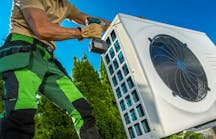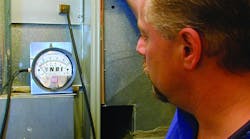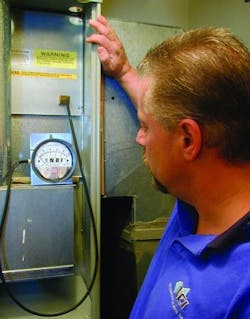Many HVAC business owners have been burned trying to implement the “home performance” concept into their business. They invested $25,000 or more in test instruments and training, only to find that the fancy new testing equipment soon makes its way into a storage closet at the shop collecting dust instead of collecting sales dollars at customer’s homes as they were promised. They discovered that performing four-hour “home performance science experiments” annoyed many customers and ticked off their sales staff. Their attempts resulted in very few sales and they found it difficult to justify and sustain their efforts.
Does this mean Home Performance is dead? Absolutely not! The problem is perspective.
When you look at Home Performance through the eyes of a building scientist, everything starts with solving the building shell issues found in most of the older homes encountered on a regular basis. While this is critically important, it’s new territory for HVAC professionals. Most HVAC companies don’t work on windows, doors, building insulation, crawlspace encapsulation, building shell pressure sealing and thermal bypasses. It’s foreign work and winds up shifting the customer’s dollars to other businesses.
When we get the HVAC system working right, many of the issues associated with the building can be resolved as DIY projects performed by the customer or a trusted subcontractor that can take on the issues you discover.—David Holt
When you look at Home Performance through the eyes of the HVAC business, things begin to take on a much more familiar look and feel. The heart and lungs of true Home Performance begins with the Comfort System – the HVAC equipment, IAQ accessories, controls and duct — all the things we already know and love. When we get the HVAC system working right, many of the issues associated with the building can be resolved as DIY projects performed by the customer or a trusted subcontractor that can take on the issues you discover.
Redefining Home Performance
Let’s redefine Home Performance by looking through the eyes of the HVAC professional. Here are ten facts you should consider about “Home Performance as a Service” (HPaaS):
Maximizing Your Best Lead Source
Everyone agrees that the greatest sales lead source in the residential/light commercial HVAC service and replacement business is maintenance agreement customers. This is true because they know you and you know them. There’s a certain level of trust enjoyed in this mutually beneficial, long-term relationship. Since trust is already established, customers are more likely to listen to your advice and will typically invest more in their home comfort systems based on your recommendations.
Who’s responsible for maintaining and nurturing this important relationship? To be sure, it’s a team effort involving Marketing Coordinators, Customer Service Representatives, Dispatchers, Service Technicians, Comfort Advisors and even the Accounts Receivable clerk. But the “face” of the team is the Service Technician. They have the most important job because they’re seen as the comfort system expert. That perceived expertise provides increased credibility and the customer typically trusts advice provided by the technician. With this in mind, properly trained service technicians can be your best lead generators when adding HPaaS to your business model.
Here’s your biggest challenge: many technicians don’t like to perform sales work! You have to help them understand that they are providing a service to their customer when they alert them to Home and System Performance issues, not trying to sell them something they don’t want or need.
You must equip technicians to do an even better job than they already perform. With a few basic test instruments and additional training, they can greatly improve their service to your customers. Plus, it will help them solve one of the most frustrating problems they face – those times when the equipment is working perfectly but the customer still has valid comfort complaints and remains dissatisfied. All technicians hate not being able to resolve those situations.
Discovering Hidden Opportunities
The key to getting your technicians onboard with HPaaS is teaching them how to accurately measure HVAC System Performance – the “heart and lungs” of Home Performance. In 1883, Lord Kelvin said “When you can measure what you are speaking about and express it in numbers, you know something about it. But when you cannot measure it or when you cannot express it in numbers, your knowledge is of a meager and unsatisfactory kind.” In a nutshell, Lord Kelvin was saying “if you don’t measure, you’re just guessing.” Technicians don’t like to guess, they like to know how to solve problems for their customers.
When you go to the doctor’s office, they start off by measuring your weight, pulse, blood pressure and body temperature. These initial measurements provide valuable information that leads to further diagnostic questions, procedures and prescriptions. The same kind of initial measurements must be used to determine the health of your customer’s HVAC system.
A properly trained and equipped service technician measures pressure and temperature to determine if the HVAC system is performing as designed. Most technicians already take temperature and pressure measurements at the equipment (temperature drop/rise across evaporator coils/heat exchangers and refrigerant pressures) but those measurements only tell part of the story. Technicians must also measure static pressure and “system” temperatures to better understand true HVAC System Performance.
Static Pressure is a Critical Measurement
When doctors measure high blood pressure situations, they prescribe appropriate solutions to resolve the issue. Measuring the “total external static pressure” (TESP) of the air handling equipment works the same way. When you discover high TESP, you can prescribe appropriate measures to resolve the resulting reliability, noise, comfort and energy efficiency issues that are sure to be present. (Relating TESP to blood pressure really helps everyone better understand what you’re talking about, too!)
For example, let’s say you installed a 4-ton Lennox system using a CB29M-65 fan coil designed to deliver 1,560 CFM at .50” W.C. using the Medium-Low speed tap. The actual TESP is measured at .90” W.C., reducing the CFM to 1,280 --- an 18% reduction in airflow! A little over three-quarters of a ton of the required 1,600 CFM airflow is not making it out of the unit. Wonder why those rooms farthest away from the equipment aren’t comfortable?
But, we have a smart technician that looks at the Blower Performance table and finds that he can change the speed tap to High and get 1,595 CFM out the unit at a .90” W.C. TESP so he makes the change. He leaves the home, only to get a call from the customer a few months later complaining about the equipment noise and their power bills went way up. Looking at the Blower tables again, our technician notices that the watts used by the motor on Medium-Low (at .90” W.C.) is 545 while it jumps up over 60% to 875 watts when running on the High speed tap. Ooops! We need to figure out why the TESP is so high and resolve it!
Remember this: Total External Static Pressure is the “blood pressure” of an HVAC system. When a doctor measures high blood pressure, they don’t just speed up your heart rate to overcome the problem. They find out what is causing the high pressure conditions and work to resolve the issues. You need to do the same! Find out the cause and resolve the issue. High TESP equals lower airflow, noisier operation, shortened motor life and higher power bills which all results in unhappy customers.
You can also use static pressure measurements to determine the cleanliness of evaporator coils and air filters. Static pressure measurement can help you figure out if there are air flow restrictions in the supply or return side of the duct system. It can even help you identify which fittings in a duct system are the biggest culprits in reducing system air flow. Static pressure measurement is a critical step in fully understanding how well the HVAC system is operating as installed.
Temperature Tells More of the Story
What about temperature measurements? By measuring just a few extra temperatures in the living space, you’ll also discover hidden issues affecting your HVAC System’s performance. Let’s look at the following system temperature measurements:
If we look at the “typical” temperatures measured at the equipment, we would think everything is running great since we have a 20 degree temperature drop (80 – 60 degrees) across the evaporator coil. However, when we look at the average Supply and Return temperatures measured in the living space, another picture is presented. On the Return side, we determine a 5 degree temperature gain (80 – 75 degrees) and a 5 degree temperature gain (65 – 60 degrees) on the Supply side. That may not seem like much, but that 10 degree combined difference (75 – 65 degrees) accounts for 50% (10 / 20 degrees) of our cooling capacity. (SEE FIGURE 1).
Wonder why that thermostat keeps calling all the time and customers complain about high utility bills?
Time to Turn It Over to the Team
With these simple readings, you can tell a lot about the health of the customer’s HVAC system, but it’s only the beginning. Equipped with this initial data, it’s easy for the technician to say “I’m seeing some things that concern me and I’m going to turn my measurements over to the office for further investigation.”
Just like at the doctor’s office, the technician that weighs you, measures your pulse, takes your temperature, checks your blood pressure, or collects fluid samples is not the person to discuss their measurements with you. That’s turned over to the folks in the Lab and ultimately to the doctor. You should follow the same pattern.
Technicians collect initial vital statistics on the HVAC system. Office personnel can evaluate the findings, create reports and notify the customer that additional diagnostics may be indicated. Finally, your Comfort Advisor can prescribe next steps based on further investigation. You’re now in front of a good customer that trusts you and you’re armed with great solutions to hidden problems.
Looking Beyond the Box
Technicians can easily perform initial assessments of the HVAC systems and visual inspections of structural systems, but advanced diagnostics are required to get the full picture. When checkups indicate problems, more testing is usually prescribed. The Comfort Advisor must follow a structured process to evaluate the customer and technical requirements in the home.
Investing 10 to 15 minutes on the front end of the visit asking questions that direct you to the next level of testing is a critical step that many overlook. Think about this – your customer has been living there for years and they know the comfort of their home much better than you – even with all your tools, training and experience. Don’t overlook the value of asking them what their concerns are and focusing on solutions to those issues, first! (Can you imagine a doctor not collecting your family medical history prior to making recommendations?)
In addition to complete HVAC system renovations, you are likely to encounter the following Comfort System defects that will need to be addressed since they negatively affect the safety, health, comfort and efficiency of your customer’s home:
Insulation Defects - Proper comfort and efficiency requires proper insulation.
Structure Air Leaks - Uncontrolled infiltration and exfiltration causes many problems. You can’t condition a space properly with significant structure air leaks.
Air Duct Leakage - When air ducts leak, customers complain more. Return leaks create a positive pressure in the home. Supply leaks cause a negative pressure in the home leading to unsafe gas appliance operation and high dust levels.
Pressure Imbalances - Pressure drives safety, health, comfort and efficiency concerns. What happens to room pressures when interior doors close?
Delivered Air Flow - Comfort is delivered via the proper air volume. If a room requires 300cfm, you better be sure it gets all of it.
As you can see, adding Home Performance as a Service leads to more work for your team and happier customers that pay their bills and refer you more often. It truly is a win-win-win situation that you should seriously consider.













